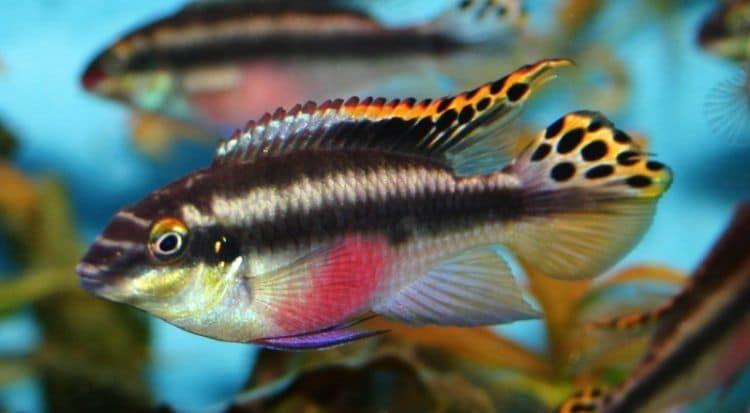
The Pelvicachromis pulcher, otherwise commonly referred to as the Kribensis, or the Purple Cichlid, is a dwarf African cichlid, not of the rift lakes, but rather, in the wild it would be found in the rivers of Nigeria, often in brackish water. This species stays relatively small for a cichlid, reaching between three and four inches (standard body length), making them ideal for smaller tanks than is usual for a cichlid in which to be kept. A tank as small as fifteen gallons, (2 ft X 1 ft X 1 ft) can be used to breed and raise the Kribensis.
In an unusual twist to the sexual dimorphism (differences between males and females) commonly found in fish, the members of the Pelvicachromis species tend to have the female more vividly coloured and marked than the male. In the case of the Kribensis, the base body colour is muted olive with a dark lateral stripe running from the mouth below the eye all the way to the tail. Below the stripe, the belly of the male is pale pinkish white, with the females having dark red or purple-red. The female may often sport a bright contrasting patch of yellowish-green at the lower mouth and throat region. The males have translucent dark fins with dark spotting, each spot being surrounded by yellow and with each fin edged in yellow to orange. Unless actively breeding, these colours will remain muted and translucent in the male. While breeding, they will intensify and become more solid. In the female, these markings are always solid and brilliantly coloured.
This fish prefers to be kept at water temperatures of between 75 to 80 degrees Fahrenheit, with a water hardness of between 8-12 dGH (medium hard water). Well-planted aquaria, providing caves and overturned flowerpots for spawning are preferred, but open areas should also be provided for swimming. The substrate should ideally be fairly fine so that the Kribensis may burrow and dig pits for fry if desired. Plants will not be damaged by this, as the Kribensis is not a vigorous and messy digger, nor will it eat or tear up plants.
Kribensis are considered to be an easy fish to keep and breed, as they do not grow too large, nor are they overly aggressive except while breeding, and they are fairly undemanding about water requirements. They seem to be less sensitive than other fishes toward somewhat careless water maintenance practices, with nitrate damage not often seen.
Breeding pairs should be kept to themselves, as a good pair of parents will protect and guard their eggs and fry from any other species, regardless of size. Eggs are typically laid on the underside of the roof of a cave, or overturned flowerpot (if provided), with large overhanging leaves of bushy plants being an acceptable substitute. Clusters of between 150-300 eggs may be laid and guarded vigorously by the female, while the male defends the outside territory. Once the fry are free-swimming, good parents may take turns guarding the school.
Spawning may take place as often as every three weeks, but in order to keep previous spawns, it may be necessary to remove them from the parents before the next spawn, as the parents may turn on the older fry. Feeding fry can be done by using very finely ground flake foods designed for fry, or by using newly hatched baby brine shrimp in combination with flake foods. It is usually not necessary to use infusoria as the fry are fairly large.
Recommending these fish for a relative newcomer to the hobby of fish-keeping would be easy, as these fish can be quite tough and with very little difficulty, very beautiful. Triggering these fish is easy, and as a means of encouraging new fishkeepers to become more engrossed in the hobby, it would be hard to find a better candidate than the Pelvicachromis pulcher – the Kribensis.
Leave a Reply